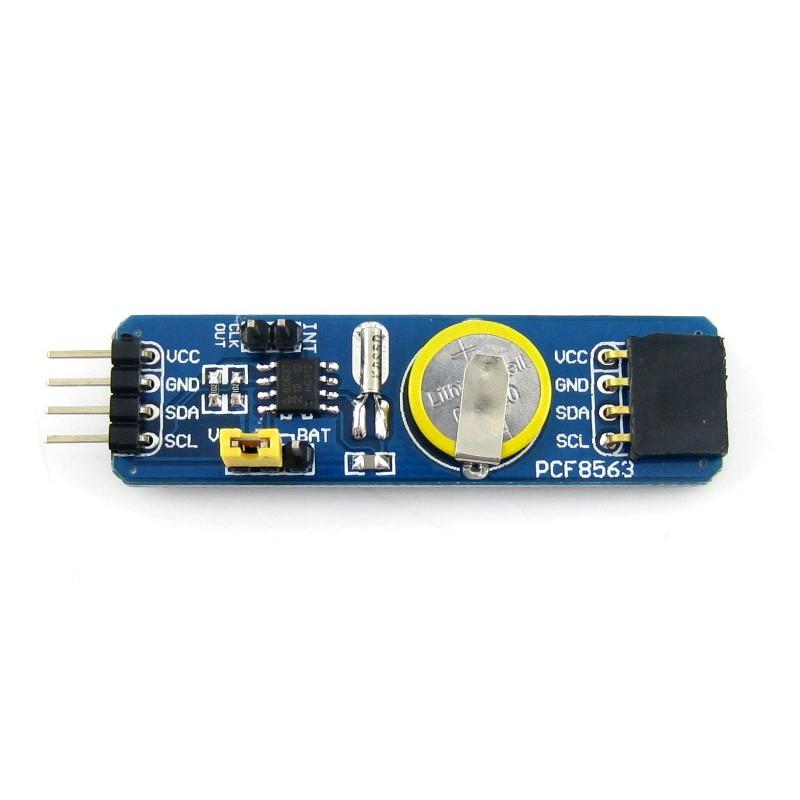The PCF8563 is a CMOS Real-Time Clock (RTC) and calendar optimized for low power consumption. A programmable clock output, interrupt output, and voltage-low detector are also provided. All addresses and data are transferred serially via a two-line bidirectional I²C-bus. Maximum bus speed is 400 kbit/s.
Features
Connection
| Wemos Pin | Module Pin |
| 5v | Vcc |
| GND | Gnd |
| D1 | SCL |
| D2 | SDA |
Code
You do not need a library but I downloaded the library from https://bitbucket.org/orbitalair/arduino_rtc_pcf8563/downloads
This is one of the basic examples, I tested this on a Wemos Mini and Arduino and the results were identical
/* Demonstration of Rtc_Pcf8563 Alarms.
*
* The Pcf8563 has an interrupt output, Pin3.
* Pull Pin3 HIGH with a resistor, I used a 10kohm to 5v.
* I used a RBBB with Arduino IDE, the pins are mapped a
* bit differently. Change for your hw.
* SCK - A5, SDA - A4, INT - D3/INT1
*
* After loading and starting the sketch, use the serial monitor
* to see the clock output.
*
* setup: see Pcf8563 data sheet.
* 1x 10Kohm pullup on Pin3 INT
* No pullups on Pin5 or Pin6 (I2C internals used)
* 1x 0.1pf on power
* 1x 32khz chrystal
*
* Joe Robertson, jmr
* orbitalair@bellsouth.net
*/
#include <Wire.h>
#include <Rtc_Pcf8563.h>
/* get a real time clock object */
Rtc_Pcf8563 rtc;
/* a flag for the interrupt */
volatile int alarm_flag=0;
/* the interrupt service routine */
void blink()
{
alarm_flag=1;
}
void setup()
{
pinMode(3, INPUT); // set pin to input
digitalWrite(3, HIGH); // turn on pullup resistors
Serial.begin(9600);
/* setup int on pin 3 of arduino */
attachInterrupt(1, blink, FALLING);
/* clear out all the registers */
rtc.initClock();
/* set a time to start with.
* day, weekday, month, century, year */
rtc.setDate(14, 6, 3, 0, 10);
/* hr, min, sec */
rtc.setTime(1, 15, 40);
/* set an alarm for 20 secs later...
* alarm pin goes low when match occurs
* this triggers the interrupt routine
* min, hr, day, weekday
* 99 = no alarm value to be set
*/
rtc.setAlarm(16, 99, 99, 99);
}
void loop()
{
/* each sec update the display */
Serial.print(rtc.formatTime());
Serial.print(" ");
Serial.print(rtc.formatDate());
Serial.print(" 0x");
Serial.print(rtc.getStatus2(), HEX);
Serial.print("\r\n");
delay(1000);
if (alarm_flag==1){
clr_alarm();
}
}
void clr_alarm()
{
detachInterrupt(1);
Serial.print("blink!\r\n");
rtc.clearAlarm();
delay(1000);
alarm_flag=0;
attachInterrupt(1, blink, FALLING);
}
Links




Above code works on ESP8266-12E, only you need to add Serial.begin(9600);
connect PCF8563 SCL to GPIO5 and SDA to GPIO4.